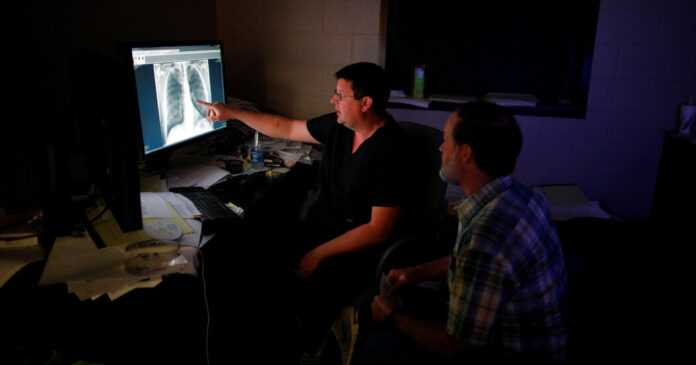Federal regulators on Tuesday will issue new protections for miners against a type of dust long known to cause deadly lung ailments — changes recommended by government researchers a half-century ago.
Mining companies will have to limit concentrations of airborne silica, a mineral commonly found in rock that can be lethal when ground up and inhaled. The new requirements will affect more than 250,000 miners extracting coal, a variety of metals, and minerals used in products like cement and smartphones. Tuesday’s announcement is the culmination of a tortuous regulatory process that has spanned four presidential administrations.
Miners have paid dearly for the delay. As progress on the rule stalled, government researchers documented with growing alarm a resurgence of severe black lung afflicting younger coal miners, and studies implicated poorly controlled silica as the likely cause.
“It should shock the conscience to know that there’s people in this country that do incredibly hard work that we all benefit from that are already disabled before they reach the age of 40,” said Chris Williamson, head of the Mine Safety and Health Administration, which is issuing the rule. “We knew that the existing standard was not protective enough.”
The new requirements are to be announced by Acting Secretary of Labor Julie Su at an event in Pennsylvania Tuesday morning. They come eight years after a sister agency, the Occupational Safety and Health Administration, issued similar protections for workers in other industries, such as construction, countertop manufacturing and fracking.
Both mine safety advocates and industry groups generally support the rule’s central change: halving the allowed concentration of silica dust. But their views on the rule, proposed last July, diverge sharply over enforcement, with mining trade groups arguing that the requirements are unnecessarily broad and costly, and miners’ advocates cautioning that companies are largely left to police themselves.
The dangers of breathing finely ground silica were evident almost a century ago, when hundreds of workers died of lung disease after drilling a tunnel through silica-rich rock near Gauley Bridge, W.Va. It remains one of the worst industrial disasters in U.S. history.
In 1974, the National Institute for Occupational Safety and Health, a federal research agency, recommended reducing the existing limits on silica in the air workers breathed. For years, the report languished.
The agency reiterated its recommendation in 1995, and a Labor Department advisory committee reached the same conclusion the following year. Both also advised overhauling the existing enforcement for coal mines — a complicated arrangement in which regulators tried to control silica levels by reducing dust overall.
In 1996, work began on a rule to empower regulators to police levels in coal mines. The effort was later broadened to include lowering the silica limit for all miners, but it repeatedly stalled during George W. Bush’s, Barack Obama’s and Donald J. Trump’s presidencies.
In interviews, the heads of the agency during the Clinton and Obama administrations described a mix of politics, industry opposition and competing priorities that impeded progress on a silica rule. Both said they had prioritized a separate rule to regulate overall dust levels in coal mines, which also took years to complete and was finalized in 2014.
“I regret that we didn’t get many things done, and silica is one of those,” said Davitt McAteer, who ran the agency from 1994 to 2000.
Joe Main, who led it from 2009 to 2017, said his agency had planned to draw on work by O.S.H.A., which also faced lengthy delays before issuing its 2016 silica rule. “But the clock ran out on our administration,” he said.
Meanwhile, after years of declining rates of black lung, caused by breathing coal and silica dust, rates of the severe form of the disease had surged. In the 1990s, less than 1 percent of central Appalachian miners who had worked at least 25 years underground had this advanced stage of illness. By 2015, the number had risen to 5 percent.
Because of changes in mining practices, workers were cutting more rock, producing more silica dust. The effects began showing up on chest X-rays and in tissue samples taken from miners’ lungs. Clinics in Appalachia began seeing miners in their 30s and 40s with advanced disease.
“Each of these cases is a tragedy and represents a failure among all those responsible for preventing this severe disease,” a team of government researchers wrote in a medical journal in 2014.
While the rule to be issued Tuesday adopts the limit recommended in 1974, some miner-safety advocates worry that its benefits will be undercut by weak enforcement. The regulations largely leave it to mining companies to collect samples showing they are in compliance, despite evidence of past gamesmanship and fraud. Miners have described being pressured to place sampling devices in areas with far less dust than where they actually worked, leading to artificially low results.
Mr. Williamson said his agency protects miners who blow the whistle on unsafe conditions and works with the Justice Department to pursue criminal cases if they learn of sampling fraud.
Industry groups, meanwhile, argued after the rule was proposed that it was too strict. They asked the agency to scale back the sampling requirements and allow greater flexibility in approaches to reducing dust levels.
The provisions remained mostly unchanged in the final rule.
Companies mining materials other than coal have expressed particular concern about the cost of a new program requiring them to provide free periodic medical exams to workers. A similar program already exists in coal mining.
Mr. Williamson defended the program as a key way for miners to track their health and for researchers to track disease.
The rule’s effectiveness may not be clear for years, as lung disease can take time to develop. Mr. McAteer and Mr. Main said they were dismayed by the recent resurgence of disease and expressed regret that they had not enacted a silica rule.
“We could have done more,” Mr. Main said. “I wish we did more.”
Credit: Source link

















